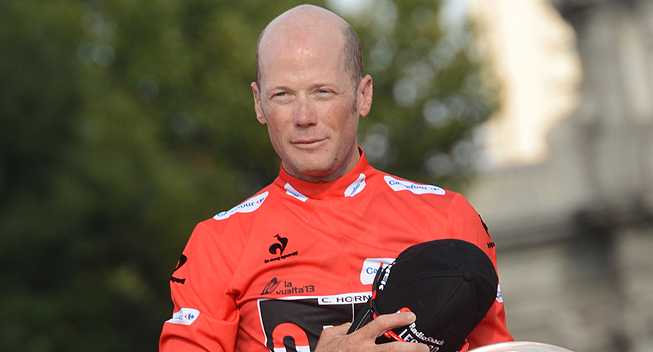Chris Horner became the oldest winner of a GT, when he won the Vuelta a Espana this year. Since his victory, the doping suspicions have only grown bigger and it continues. Physician Michael Puchowicz has examined Horner’s blood values and the result is not good.
Under this year’s Vuelta, Horner was almost unbeatable and even Vincenzo Nibali was in problems against the strong American. Horner ended up winning the Vuelta, but even before he won the GC, doping suspicions were thrown against him. The suspicions made him publish his blood values in order to prove his innocence. But the publication has now worsened the situation for the American.
Michael Puchowicz has examined and raised doubt about Horner’s values. His conclusion was published on outsideonline.com Tuesday. Puchowicz is known as one of the persons who raised doubt about Lance Armstrong before he was banned from the sport. He raises doubt about two things in the values.
The first thing is his haemoglobin concentrations. Haemoglobin is a protein, which transports oxygen around the body. The more oxygen you can transport, the better you can perform. For a 41 year old rider, the haemoglobin concentration will normally only drop with 9 per cent during a GT.
“A higher-than-expected hemoglobin concentration is exactly what is seen in Horner's data in the second half of the Vuelta. On August 22, Horner's pre-Vuelta hemoglobin is measure at 15.2 g/dL. Early in the race, this value decreases to 14.4 g/dL, before dropping to a race low of 13.5 g/dL on September 4, a decrease of 11 percent. This would be expected as the stress of the grand tour dilutes the blood, lowering the concentration and expanding blood volume. But then his hemoglobin values rebound to 14.3 g/dL and finish at 14.6 g/dL. The last value is the highest in race value from the entire Vuelta,” Puchowicz says to outsideonline.com.
The second thing was Horner’s reticulocyte count.
“Reticulocytes are immature red blood cells. They are present in the blood in higher numbers when the bone marrow is rapidly producing new red blood cells and in lower numbers when the bone marrow is suppressed. When an athlete transfuses red blood cells or finishes a course of EPO the bone marrow is suppressed because of the excess hemoglobin. Anytime the reticulocyte count is lower than expected it is an indication that a course of EPO or a blood transfusion may have been used,” Puchowicz says.
“Horner’s in-race Vuelta reticulocyte counts include the lowest observed value from his entire profile at 0.39. The four in-race values average out to 0.51+/- 0.08, compared to 0.76 +/- 0.18 for the remainder of bio passport. These averages suggest a suppression of 33% during the Vuelta—a statistically significant difference. (p < 0.05). The statistics tell us that suppression was unlikely to occur from random chance alone.”
Anti-doping authority Robin Parisotto has been notified with the numbers and he has said the following:
“It is not 100 per cent clear that there is anything untoward happening, but there are certainly unusual patterns. Most of the blood values that come across to us are suspicious. Most are there for a reason. What I have seen with this particular profile is similar to those other profiles."
Horner hasn’t signed a contract for the 2014 season.
| Jorge CASTEL 36 years | today |
| Marc SOLER 31 years | today |
| Andre ROOS 22 years | today |
| Jeroen KREGEL 39 years | today |
| Sophie ENEVER 25 years | today |
© CyclingQuotes.com









